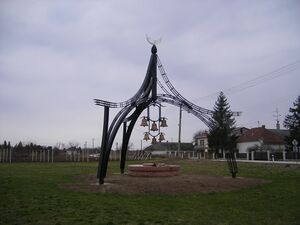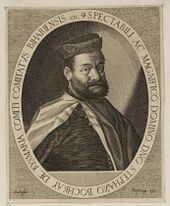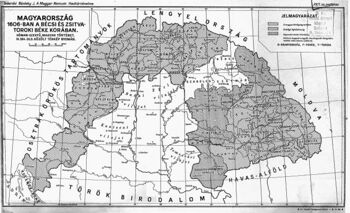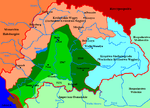معاهدة زيتڤاتوروك
 نصب سلام زيتڤاتوروك في رضوان ناد دونايوم | |
| النوع | Peace |
|---|---|
| وُقـِّعت | 11 نوفمبر 1606 |
| المكان | زيتفاتوروك |
| الموقعون الأصليون | |
| الأطراف | |
| اللغات | التركية العثمانية المجرية |
معاهدة زيتڤاتوروك إنگليزية: Peace of Zsitvatorok (مجرية: Zsitvatoroki béke; سلوڤاكية: Žitavský mier; تركية: Zitvatorok Anlaşması) كانت معاهدة سلام أنهت حرب الثلاثين عاماً بين الدولة العثمانية وملكية هابسبورگ في 11 نوفمبر 1606. المعاهدة كانت جزءاً من نظام معاهدات سلام أنهى الانتفاضة المضادة للهابسبورگ التي تزعمها إستڤان بوسكاي (1604-1606).
المعاهدة وُقعت عند المصب السابق لـنهر زيتاڤا الذي يرفد في الدانوب في المجر الملكية (سلوڤاكيا الحالية).
ولما تولَّى السلطان أحمد الأول استمرت الحرب مع النمسا، واستعاد العثمانيون "إستركون" بعد حصار شديد بعد أن ظلت أسيرة في أيدي النمساويين عشر سنوات، كما استعادوا بعض القلاع، ووصل الجيش العثماني إلى أقصى الشمال الشرقي من المجر.
أدركت النمسا خسارتها في الحرب فطلبت الصلح، وكان هذا مطلبًا عثمانيًا حتى تتفرغ الدولة لحربها مع إيران، فعُقدت معاهدة بين الطرفين عُرفت باسم معاهدة ستفاتوروك في (10 من رجب 1015هـ = 11 من نوفمبر 1606)، وانتهت بها تلك الحرب التي استمرت نحو ثلاث عشرة سنة ونصف السنة.
وبمقتضى هذه المعاهدة دفعت النمسا إلى الدولة العثمانية غرامة حرب قدرها 67000 سكة ذهبية، وأُلغيت الجزية التي كان يدفعها إمبراطور النمسا إلى الدولة العثمانية كل سنة، وثبتت الحدود على أساس أن لكلٍ الأراضي الموجودة تحت سيطرته، وأن تخاطب الدولة العثمانية حاكم النمسا باعتباره إمبراطورًا لا ملكًا، يقف على قدم المساواة مع السلطان العثماني.
The treaty was signed by Sultan Ahmed I and Archduke Matthias of Austria on behalf of the Holy Roman Empire. On 9 December, Matthias's brother the Emperor Rudolf II ratified the treaty.[1] The Ottomans' inability to penetrate further into Habsburg territory (Royal Hungary) during the Long Turkish War was one of their first geopolitical defeats. However, the treaty stabilized conditions on the Habsburg-Ottoman frontier for half a century for the benefit of both parties. The Habsburgs would face serious domestic opposition during the following years, and the Ottomans, apart from internal rebellion, had open conflicts in other parts of their frontiers (Poland and Iran).
At Zsitvatorok, for the first time, the Ottoman sultan, who carried the title Kayser-i Rûm (Caesar of the Roman Empire) since the Fall of Constantinople, recognised the equality of status of the Holy Roman Emperor by titling him Padishah (Emperor or, more literally, "Master King"), which was the sultan's own title. That was seen as an acceptance of divisio imperii in which imperial hegemony would be divided into West (the Holy Roman Empire) and East (the Ottoman Empire). Before then, the Holy Roman Emperor was regarded as mere kral (king) of Vienna in Ottoman diplomacy. The next European ruler to be conceded that level of respect was Catherine the Great of Russia in the Treaty of Küçük Kaynarca of 1774.[2][3]
The treaty explicitly included the Crimean Khanate as a vassal of the Ottoman Empire.[4]
. . . . . . . . . . . . . . . . . . . . . . . . . . . . . . . . . . . . . . . . . . . . . . . . . . . . . . . . . . . . . . . . . . . . . . . . . . . . . . . . . . . . . . . . . . . . . . . . . . . . . . . . . . . . . . . . . . . . . . . . . . . . . . . . . . . . . . . . . . . . . . . . . . . . . . . . . . . . . . . . . . . . . . . .
The points and signatories of peace
 Bocskai István erdélyi fejedelem |
|---|
انظر أيضاً
- ^ خطأ استشهاد: وسم
<ref>غير صحيح؛ لا نص تم توفيره للمراجع المسماةSetton - ^ Bernard Lewis, What Went Wrong?: Western Impact and Middle Eastern Response (Oxford University Press, 2002), pp. 12 and 164, n. 3. In the Russian treaty, the title was Padischag (in Italian).
- ^ Mehmet Sinan Birdal, The Holy Roman Empire and the Ottomans: From Global Imperial Power to Absolutist States (I. B. Tauris, 2011), p. 6.
- ^ Kenneth Meyer Setton, Venice, Austria, and the Turks in the Seventeenth Century (American Philosophical Society, 1991), p. 22.
- Short description is different from Wikidata
- Articles containing إنگليزية-language text
- Pages using Lang-xx templates
- Articles containing مجرية-language text
- Articles containing سلوڤاكية-language text
- تأسيسات 1606
- 1606 في اوروبا
- معاهدات المجر
- تاريخ سلوڤاكيا
- معاهدات الدولة العثمانية
- معاهدات 1606
- القرن 17 في الدولة العثمانية
- معاهدات سلام الدولة العثمانية
- معاهدات سلام النمسا
- معاهدات ملكية هابسبورگ







